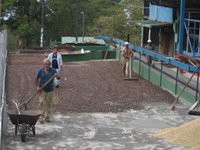Coffee Joke of The Day
| What Kind of Coffee Drinker Are You? When ordering coffee at a shop, what size do you generally prefer? a. Large b. Extra Large c. Bladder Buster 2000 (c) What do you enjoy most about coffee? a. The aroma b. The flavor. c. The chest pains. Finish this sentence: "When I'm not drinking coffee, I'm..." a. ...thinking about coffee. b. ...planning on drinking coffee soon. c. ...eating coffee grounds. What kind of bean do you prefer? a. Sumatran b. Guatemalan c. I don't care, JUST GIVE ME SOME NOW!! Finish this sentence: "Coffee makes me..." a. Think better. b. Feel better. c. ttTTtypPPpeEE bettRReeRr. If a waitperson asks if you would like a coffee refill, you answer: a. "Yes, please." b. "Of course." c. "Well, duh!" An extremely cute guy/gal asks you if they can share your coffee with you. What do you do? a. Say, "Sure!" b. Say, "No, thank you." c. Threaten bodily harm. What best describes coffee? a. Delicious refreshment. b. A quick pick-me-up. c. Life blood. How close is the closest coffee shop to your home? a. More than three city blocks. b. Less than three city blocks. c. I'm homeless. I spent all my money on coffee. What's the worst part about drinking coffee? a. The aftertaste. b. Stopping. c. Can you repeat the question? I haven't slept in four days... Scoring: All A answers get 10 points. All B answers get 5 points. All C answers get 2 points. Score: 100 - 50 = You like to drink coffee. 50 - 22 = You like to drink coffee a lot. 20 = You could drink Juan Valdez under the table. ( Juan Valdez is a fictional character that has appeared in advertisements for the National Federation of Coffee Growers of Colombia since 1981, representing the Colombian coffee farmer.The goal was to distinguish 100 per cent Colombian coffee from coffee blended with beans from other countries.He made his first TV appearance in 1983.He often appears alongside a mule, and he has become an icon for Colombia as well as coffee in general. ... ) |





 Espresso appears dark brown with a red/brown-colored foam, called
Espresso appears dark brown with a red/brown-colored foam, called